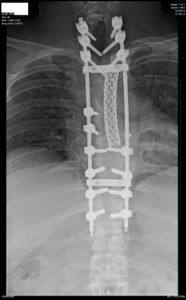Submitted by Dr. Ankeney for Kaiser Permanente
The sun had not quite risen when an explosion tore through Sergeant Blake’s* Humvee. Through the injuries he would sustain in the bombing, Sgt. Blake made huge contributions to our understanding of how to overcome chronic pain.

Sgt. Blake injuries were located mostly in his spine. Wracked with daily almost-blinding pain, Sgt. Blake underwent surgery after surgery on his crushed back. Most of the vertebrae were removed from his thoracic spine.
But none of it helped for long. Soon he had been replaced as the leader of his Special Forces unit. His career, his life, was falling apart as he tried unsuccessfully to even make it a few hours on his feet or in a chair.
In desperation, Blake enrolled in a special U.S. Army rehab unit. There, he underwent intensive physical therapy (PT) focused not on eliminating chronic pain nor on finding a few hours of relief in a pain-filled day. The focus was to put him back on the line with his unit.
Along with hours of daily PT, Sgt. Blake participated in yoga sessions daily, acupuncture 2-3 times a week, PTSD counseling, bio-feedback and strength training. With the help of doctors specializing in treating addictions, he tapered completely off his massive daily narcotic regimen. He received fluoroscopic-guided spine injections of cortisone and radiofrequency ablations of crushed spinal nerves.
Progress was slow at first, especially because the body’s natural reaction to narcotic tapering is a heightened sense of pain. But somewhere in his misery, Sgt. Blake turned a corner. He quit hoping he could merely get out of a chair without pain, and started believing he could lead his unit again, pain or not.
Sgt. Blake was returned to full active duty with his Special Forces unit approximately 6 months after entering his intensive therapy program. He was using less than 20 narcotic pills a month for days with severe pain, and was taking zero sedatives, no muscle relaxants or sleeping pills.

The intensity of rehab available to Sgt. Blake is not typically available to civilians. But the breadth of rehab options like what Blake received is available. Yoga, PT, acupuncture, medical massage, addiction counseling and spine injections are all options for treating chronic pain. All have good data showing efficacy. None rely on narcotic or other serious medicines to work well.
So there is hope for people with chronic pain. Hope beyond sitting in a chair, dependent on heavy medicines, living a life restricted by pain. But perhaps it should be pointed out that Sgt. Blake approached his dire situation with one other extremely important component: an iron-willed determination to live as much life as he possibly could. Follow his lead, and there’s a good chance just about anyone with chronic pain can also fully participate in all the action of life.
“Team,
I wanted to pass you a hello and some further feedback… not only did I successfully finish my latest tour deployment, but I recently completed 5 military free fall jumps with full combat equipment, ruck, weapon, and O2 over five nights… including some decently hard landings in the dark…
I was smiling inside my O2 mask and for a split second, ‘Take THAT, disc extrusion’ flashed through my mind as I sped through the night. You guys are the heat.
You forever have my deepest gratitude.
Kind Regards,
Hooligan”
*Name and rank changed for privacy. Story and image used with permission.















































